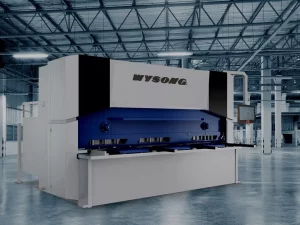Enhancing steel fabrication efficiency through hydraulic shear technology is a game-changer. Industries aiming for optimal production and meeting evolving standards must compare various shear types. Understanding the nuances of different shear technologies reveals their potential to revolutionize traditional methods.
Dive into how hydraulic shears are reshaping steel fabrication practices for operational excellence.
Key Takeaways
- Hydraulic shears offer faster cutting speeds and increased cutting capacity, improving efficiency in steel fabrication processes.
- Upgraded shear technology enhances precision, safety features, and productivity, leading to minimized material wastage and reduced accidents.
- When comparing shear types, factors like cutting capacity, precision, accuracy, speed, and maintenance requirements should be carefully evaluated to ensure optimal performance.
- Choosing the right hydraulic shear based on cutting capacity, material compatibility, speed, accuracy, and automation features can significantly optimize workflow and enhance efficiency in steel fabrication facilities.
Understanding Hydraulic Shear Technology
Understanding Hydraulic Shear Technology plays a crucial role in the efficiency and precision of steel fabrication processes. Hydraulic shears are essential tools used in cutting various types of metal, including steel, with high accuracy and speed. These machines operate by utilizing hydraulic force to generate the power needed for cutting through the metal sheets. The technology behind hydraulic shears involves a combination of hydraulic cylinders, a motor, a pump, and a cutting blade.
Hydraulic shears offer several advantages over traditional mechanical shears, such as faster cutting speeds, increased cutting capacity, and improved precision. The hydraulic system allows for better control over the cutting process, resulting in smoother cuts and reduced material waste. Additionally, hydraulic shears can handle a wide range of sheet metal thicknesses, making them versatile for different fabrication needs.
Key Factors in Comparing Shear Types
When evaluating shear types for steel fabrication, it is critical to analyze key factors to determine the most suitable option for specific cutting needs. To make an informed decision, consider the following factors:
- Cutting Capacity: Evaluate the maximum thickness and width of steel that each shear type can effectively cut. Understanding the cutting capacity ensures the shear can handle the required workload.
- Precision and Accuracy: Look into the shear’s ability to consistently produce accurate cuts. Precision is crucial for maintaining quality and minimizing material waste.
- Speed and Efficiency: Assess the cutting speed of different shear types to determine which one can optimize production efficiency without compromising quality.
- Maintenance Requirements: Consider the maintenance needs of each shear type. Understanding the upkeep demands can help in planning for downtime and ensuring continuous operation.
Benefits of Upgraded Shear Technology
Enhancing steel fabrication efficiency through the adoption of advanced shear technology entails a strategic consideration of the benefits offered by upgraded shear equipment.
Upgraded shear technology brings a myriad of advantages to steel fabrication processes. Firstly, precision is significantly enhanced with advanced shear technology, ensuring accurate cuts and minimizing material wastage. This precision is crucial in maintaining the quality of fabricated steel components.
Secondly, efficiency is greatly improved as upgraded shears can handle a higher workload capacity, leading to increased productivity and faster turnaround times.
Additionally, safety is a paramount benefit of upgraded shear technology, with features such as safety guards and sensors that reduce the risk of accidents in the fabrication environment.
Improved ergonomics is another advantage, as modern shear equipment is designed with user-friendly interfaces and enhanced automation, reducing operator fatigue and improving overall workflow.
Efficiency Gains in Steel Fabrication
Efficiency in steel fabrication is significantly heightened through the integration of advanced shear technology, amplifying productivity and precision in the manufacturing process. To understand the efficiency gains in steel fabrication enabled by hydraulic shears, consider the following:
- Reduced Material Waste: Hydraulic shears offer precise cutting mechanisms, minimizing material waste and optimizing the use of raw materials.
- Faster Cutting Speeds: The high cutting speeds of hydraulic shears allow for quicker processing of steel, leading to increased production output within a given timeframe.
- Enhanced Accuracy: Advanced technology in hydraulic shears ensures accurate cuts, reducing the need for rework and enhancing overall product quality.
- Improved Operator Safety: Hydraulic shears come equipped with safety features that protect operators during the cutting process, promoting a secure working environment and reducing the risk of accidents.
Choosing the Right Hydraulic Shear
The foundation of achieving optimal efficiency gains in steel fabrication lies in the meticulous selection of the appropriate hydraulic shear technology for the specific manufacturing requirements. When choosing the right hydraulic shear, several key factors must be considered to ensure that the selected equipment aligns perfectly with the operational needs of the steel fabrication facility.
One crucial aspect to evaluate is the cutting capacity of the hydraulic shear, including its maximum thickness and length capabilities. Understanding the types of materials that will be predominantly processed is also essential, as different hydraulic shear models are designed to handle varying material strengths and compositions.
Additionally, assessing the required cutting speed, accuracy, and automation features can significantly impact the overall efficiency and productivity of the steel fabrication process. By meticulously analyzing these factors and selecting a hydraulic shear that best suits the specific operational demands, steel fabrication facilities can optimize their workflow, minimize downtime, and enhance overall efficiency in the manufacturing process.

Frequently Asked Questions
Can Hydraulic Shear Technology Be Used for Materials Other Than Steel in Fabrication Processes?
Hydraulic shear technology can be utilized for various materials besides steel in fabrication processes. Its versatility and precision make it suitable for cutting a wide range of metals such as aluminum, copper, and alloys, enhancing efficiency across diverse manufacturing applications.
Are There Any Environmental Benefits Associated With Using Hydraulic Shear Technology in Steel Fabrication?
Incorporating hydraulic shear technology in steel fabrication processes can yield significant environmental benefits. These include reduced material waste, energy efficiency improvements, and enhanced precision in cutting, ultimately leading to a more sustainable and eco-friendly operation.
How Do Different Hydraulic Shear Types Compare in Terms of Maintenance Requirements?
Comparing hydraulic shear types differences vary in maintenance needs. Regular servicing schedules, lubrication requirements, and spare parts availability differ. Understanding these differences is crucial for optimal performance and longevity of hydraulic shears, ensuring efficiency in steel fabrication processes.
What Safety Measures Should Be Considered When Operating Hydraulic Shears in a Steel Fabrication Setting?
When operating hydraulic shears in a steel fabrication setting, essential safety measures include proper training for operators, regular equipment maintenance checks, wearing appropriate personal protective equipment, ensuring a clear work area, and following manufacturer guidelines meticulously to prevent accidents and injuries.
Can Hydraulic Shear Technology Be Integrated With Other Machinery to Further Enhance Efficiency in Steel Fabrication Processes?
Hydraulic shear technology can be integrated with other machinery to enhance efficiency in steel fabrication processes. By combining hydraulic shears with automation systems, such as CNC controls, manufacturers can streamline operations, reduce manual labor, and improve precision in cutting tasks.
Conclusion
In conclusion, the comparison of different hydraulic shear types reveals the potential for revolutionizing steel fabrication efficiency. Understanding the key factors and benefits of upgraded shear technology is crucial for achieving efficiency gains in metal cutting operations.
By selecting the right hydraulic shear, manufacturers can optimize production outputs and meet the demands of modern fabrication standards. Embracing innovative technologies like hydraulic shears is essential for staying competitive in the evolving industrial landscape.
You May Also Like:
